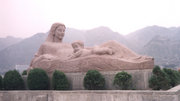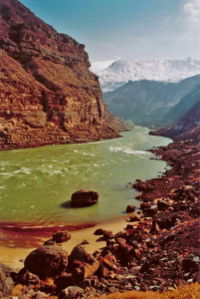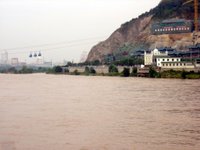Yellow River
2007 Schools Wikipedia Selection. Related subjects: Geography of Asia
| Yellow River (Huang He) | |
|---|---|
|
|
|
| Origin | Bayankala Mountains, Qinghai Province |
| Mouth | Bohai Sea |
| Basin countries | China |
| Length | 5464 km |
| Source elevation | 4500 m (14,765 ft) |
| Avg. discharge | 2,571 m³/s (90,808 ft³/s) |
| Basin area | 752 000 km² |
The Yellow River ( Traditional Chinese: 黃河; Simplified Chinese: 黄河; Hanyu Pinyin: Huáng Hé listen ; Wade-Giles: Hwang-ho, sometimes simply called the River in ancient Chinese) is the second longest river in China (after Yangtze River) and the seventh longest in the world. The river is 5464 km long . Originating in the Bayankala Mountains in Qinghai Province in western China, the Yellow river flows through nine provinces of China and empties into the Bohai Sea. The Yellow River basin has an east-west distance of 1900 km and north-south distance of 1100 km. Total basin area is 752443 km².
The middle stream of the Yellow River passes through the Loess Plateau where substantial erosion takes place. The large amount of mud and sand discharged into the river makes the Yellow River the most sediment-laden river in the world. The highest recorded annual level of silts discharged into the Yellow River is 3.91 billion tons in 1933. The highest silt concentration level was recorded in 1977 at 920 kg/m³. These sediments later deposit in the slower lower reaches of the river, elevating the river bed and creating the famous "river above ground". In Kaifeng, Yellow River is 10 meters above the ground level.
The Yellow River is called the "Mother River of China" and "the Cradle of Chinese Civilization" in China, as the Yellow River basin is the birth-place of the northern Chinese civilizations and the most prosperous region in the early Chinese history. However, the frequent devastating flooding, largely due to the elevated river bed in its lower course, has also earned it the unenviable distinction as "China's Sorrow".
Name
In the early history, the Yellow River is referred to in Chinese literatures simply as He (河), or "River". The first appearance of the name "Yellow River" (黄河) is in the Book of Han (汉书) written in the Western Han dynasty (206 BC–AD 9). The name "Yellow River" describes the perennial ochre-yellow colour of the muddy water in the lower course of the river. An alternative poetic name of the river referring to this is the Muddy Flow (Chinese: 濁流; pinyin: Zhuo Liu). The Chinese expression "when the Yellow River flows clear" is similar to the English expression "when hell freezes over".
History and Culture
The Yellow River has special importance in the origins of the Chinese civilization. It is referred to as "the Mother River" and "the Cradle of the Chinese civilization" by Chinese. Traditionally, it is believed that the Chinese civilization originated from the Yellow River basin areas.
During the long history of China, the Yellow River has been considered a blessing as well as a curse and has been nicknamed both "China's Pride" (Zhōngguó de Jiāoào) and "China's Sorrow" (Zhōngguó de Tòng). Records indicate that, from 602 BC to present, the river's course made at least 5 major large-scale changes in direction and its levees were breached more than 1,500 times. A major course change that took place in 1194 took over the Huai River drainage system throughout the next 700 years. The mud in the Yellow River literally blocked the mouth of the Huai River and left thousands homeless. The Yellow River adopted its present course in 1897 after the final course change occurred in 1855. Currently, the Yellow River flows through Jinan, capital of the Shandong province and ends in the Bohai Sea.
The river gets its yellow colour mostly from the fine-grained calcareous silts originated from the Loess Plateau which are carried in the flow. Centuries of silt deposition and diking has caused the river to flow above the surrounding farmland, making flooding a critically dangerous problem. Flooding of the Yellow River has caused some of the highest death tolls in world history, with the 1887 Huang He flood killing 900,000-2,000,000 and the 1931 Huang He flood killing 1,000,000-3,700,000. In 1938, during the Second Sino-Japanese War, the Nationalist troops under Chiang Kai-Shek broke the levees holding back the Yellow River in order to stop the advancing Japanese troops. The river at that time flooded a huge area and the floodwaters took some 500,000-900,000 lives.
Another historic source of devastating floods was the collapse of upstream ice dams in Inner Mongolia with their accompanying sudden release of vast quantities of impounded water. There have been 11 such major floods in the past century, each causing tremendous loss of life and property. Nowadays, explosives dropped from aircraft are used to break the ice dams before they become dangerous.
Sometimes the Yellow River is poetically called the Zhuo Liu (濁流), or the "Muddy Flow." The Chinese expression "when the Yellow River flows clear" is similar to the English expression "when hell freezes over."
Some of the known flood defenses used in ancient times were the building of ditches, walls (dams), levees, and rebound channels to route floodwaters around a blockage. The main problem was that the solutions were local and sometimes the dams were too small and weak for the impact. If the river broke down the defenses, it would cause far more damage than if no levees had been built.
Characteristics of the Yellow River
The Yellow River is notable for the amount of silt it carries, amounting to 1.6 billion tons annually at the point where it descends from the Loess Plateau. If the river is running to the sea with sufficient volume, 1.4 billion tons are carried to the sea. In modern times, since 1972 when it first went dry, the river has gone dry in its lower reaches, from Jinan to the sea, in most years, in 1997 for 226 days. The low volume of the river is due to increased demands on the river for use in irrigation which has increased by a factor of five since 1950. Water diverted from the river by 1999 served 140 million people and irrigated 74000 km² of land. Highest volume occurs during the rainy season, from July to October, when 60% of the volume of the river flows. Water for irrigation, on the other hand, is needed between March and June. In order to capture excess water for use when needed and for flood control and electricity generation several dams have been built, but due to the high silt load their life is expected to be limited. A proposed South-North Water Transfer Project involves several schemes to divert water from the Yangtze River, one in the western headwaters of the rivers where they are closest to one another, another from the upper reaches of the Han River, and a third using the route of the Grand Canal.
Due to its heavy load of silt the Yellow River is a depositing stream, that is, it deposits part of its carried burden of soil in its bed in stretches where it is flowing slowly. These deposits elevate the riverbed which flows between natural levees in its lower reaches. Should a flood occur the river may break out of the levees into the surrounding lower flood plain and adopt a new course. Historically this has occurred about once every hundred years. In modern times considerable effort has been made to strengthen levees and control floods.
The Yellow River Delta totals 8,000 square kilometers. However, since 1996 it has been reported to be shrinking slightly each year, through erosion.
Geography
From its sources, Gyaring Lake and Ngoring Lake, high in the Bayankala Mountains in Qinghai Province in the far west of China, the Yellow River loops north, bends south, creating the "Great Bend", and then flows generally eastwards across northern China to the Gulf of Bohai, draining a basin of 752443 km², which nourishes 120 million people.
The river is commonly divided into three stages. However, different scholars have different opinions in how the three stages are divided. This article adopts the division by the Yellow River Hydrology Committee.
Upper reaches
The upper reaches of the Yellow River is a segment starting from the source in the Bayankala Mountains and ending at Hekou County of Inner Mongolia just before turning sharply to the south. This segment has a total length of 3472 km and total basin area of 386,000 km² (51.3% of total basin area). Along this length, the elevation of the Yellow River drops 3496 metres, with an average drop of 1%.
The upper reaches can be further divided into three sections: the source, valley, and alluvial plain section. The source section flows mainly through pastures, swamps, and knolls between the Bayankala Mountains and Anemaqen Mountains. The river water is clear and flows steadily. Crystal clear lakes and sluggish meandering are characteristic in this section. The two main lakes along this section are Lake Zhaling (扎陵湖) and Lake Eling (鄂陵湖), having capacities of 4.7 billion and 10.8 billion m³, respectively. At elevations over 4260 m above sea level, they are the largest two plateau fresh water lakes in China.
The valley section stretches from Longyang Gorge in Qinghai to Qingtong Gorge in Gansu. Steep cliffs line both sides of the Yellow River. As the water bed is narrow and the average drop is large, the water flow in this section is extremely turbulent and fast. There are 20 gorges in this section, the more famous of these being the Longyang, Jishi, Liujia, Bapan, and Qingtong Gorges. The flow conditions in this section makes it the best location to build hydroelectric plants.
After emerging from the Qingtong Gorge, the Yellow River comes into a section of vast alluvial plains, the Yinchuan Plain and Hetao Plain. In this section, the regions along the river are mostly deserts and grasslands, with very few tributaries. The flow is slow and on both sides of the river. The Hetao Plain has a length of 900 km and width of 30 to 50 km. It is historically the most important irrigation plain along the Yellow River.
Middle reaches
The part of Yellow River between Hekou County in Inner Mongolia and Zhengzhou in Henan constitutes the middle reaches of the river. The middle reaches has a length of 1206 km long and basin area of 344,000 km² (45.7% of total), with a total elevation drop of 890 meters, and average drop of 0.074%. There are 30 large tributaries along the middle reaches, and the water flow is increased by 43.5% on this stage of the river. The middle reaches is the main source of the Yellow River silts, contributing 92% of the total silts.
From Hekou County to Yumenkou, the Yellow River passes through the longest series of continuous valleys on its main course, known collectively as the Jinshan Valley. The abundant hydrodynamic resources stored in this section makes it the second most suitable area to build hydroelectric power plants. The famous Hukou Waterfall is in the lower part of this valley.
Lower reaches
In the lower reaches, from Zhengzhou to the sea, a distance of 786 km, the river is confined to a levee-lined course as it flows to the northeast across the North China Plain before emptying into the Bohai Sea. The basin area in this stage is only 23,000 km² (3% of total). The total drop in elevation of the lower reaches is 93.6 meters, with an average drop of 0.012%.
The silts received from the middle reaches form sediments in this stage, elevating the river bed. During two thousand years of levee construction, excessive sediment deposits have raised the riverbed several meters above the surrounding grounds. The levee-confined Yellow River receives flows from few tributaries in this stage. Nearly all rivers to the south of Yellow River drain into the Huai River, whereas those to the north of it drain into the Hai River.
Tributaries of the Yellow River
- White River (白河)
- Black River (黑河)
- Huang River (湟水)
- Zuli River (祖厉河)
- Qingshui River (清水河)
- Dahei River (大黑河)
- Kuye River (窟野河)
- Wuding River (无定河)
- Fen River (汾河)
- Wei River (渭河)
- Luo River (洛河)
- Qin River (沁河)
- Dawen River (大汶河)
Hydroelectric power dams on the Yellow River
Below is the list of hydroelectric power stations built on the Yellow River (in bracket is the year to start operation):
- Sanmen Gorge hydroelectric power station (1960)
- Sanshenggong hydroelectric power station (1966)
- Qingtong Gorge hydroelectric power station (1968)
- Liujia Gorge hydroelectric power station (1974)
- Yanguo Gorge hydroelectric power station (1975)
- Tianqiao hydroelectric power station (1977)
- Bapan Gorge hydroelectric power station (1980)
- Longyang Gorge hydroelectric power station (1992)
- Da Gorge hydroelectric power station (1998)
- Li Gorge hydroelectric power station (1999)
- Wanjiazhai hydroelectric power station (1999)
- Xiaolangdi hydroelectric power station (2001)
Provinces and cities on the Yellow River
Originating in the Bayankala Mountains, the Yellow River now passes nine provinces, namely Qinghai, Sichuan, Gansu, Ningxia, Inner Mongolia, Shaanxi, Shanxi, Henan and Shandong. The mouth of the Yellow River is located at Dongying, Shandong.
The provinces of Hebei and Henan derive their names from the Huang He. Their names mean respectively "north" and "south of the (Yellow) River".
Major cities located along the Yellow River include (starting from the source): Lanzhou, Wuhai, Baotou, Kaifeng, and Jinan.
Flooding and changing of course
The river is extremely prone to flooding. It has flooded 1593 times in last 3000-4000 years, while its main course changed 18 times and created some of the highest death tolls in Chinese history.
Beginning in 1194, the Yellow River to the north changed its course southwards to run into the Huai River, and changed back and forth several times over the next 700 years. The resulting silting was so heavy that after the Yellow River changed back to its northerly course for the last time in 1897, the Huai He is no longer able to go through its old course. Instead it pools up into Hongze Lake, and then runs southwards towards the Yangtze River.
In 1938, during the Second Sino-Japanese War, the Nationalist troops under the orders of Chiang Kai-Shek broke the dike holding back the Yellow River in order to stop the advancing Japanese troops. This resulted in the flooding of an area covering 54,000 km² and the death of 500,000-900,000 people.



